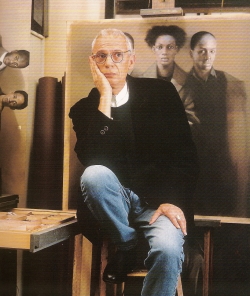Le monde de l’art vient de perdre l’un de ses grands acteurs : le peintre François Sasmayoux. est mort à Paris le 25 novembre 2006 à la suite d’une longue maladie.
Il était né en 1944 à Figeac en France, et entre 1962 et 1968 il étudia la peinture à l’Ecole des Beaux Arts de Toulouse, où il obtint son diplôme. Il s’installe ensuite à Paris où il vivra et travaillera jusqu’à la fin de sa vie.
François Sasmayousx a su trouver très vite sa ligne et son style propre, grâce notemment à la technique du pastel à laquelle il restera fidèle et qui donne ce côté très doux et un peu irréel à ses œuvres.
Il a peint des paysages, des natures mortes, mais surtout des portraits et il a consacré de grandes séries de portraits à des modéles africains dont il sait capter l’élégance avec une rare subtilité. On peut citer parmis les personnalités africaines qu’il a peint le footballeur Alain Goma, l’acteur Hubert Koundé et le mannequin et styliste Imane Ayissi, son modèle préféré. Il a exposé dans d’importantes galeries partout dans le monde comme la Galerie Elysée-Montaigne à Paris en France, la Galerie Vento Vierdé à Laredo en Espagne, la Galerie Racine à Bruxelle en Belgique, le Westries Museum à Horn en Hollande ou encore au Musée de Marrakech au Maroc et obtenu plusieurs prix comme le prix Art Dialogue en 1983, la médaille du Pastel ou le prix Edouard Bouillère à Toulouse en 1986. Il repose depuis le 30 novembre 2006 au cimetierre Montmartre où il a rejoint de nombreuses personnalités illustres. L’artiste nous a quitté mais il laisse à la postérité ses œuvres lumineuses et pleines de poésie.
François Sasmayoux was born in 1944 and was largely inspired by the 1960s. The 1960s were an explosive decade internationally, witnessing a proliferation of modernist ideas and trends. It was the era of Kennedy and Kruschev, and the start of the Cold War, which would endure for most of the second half of the twentieth century, and was epitomised most symbolically by the construction of the Berlin Wall in 1961. The Iron Curtain divided Eastern and Western Europe, both ideologically and literally, and student political uprisings took place around the world.
Psychedelia, an vast increase in consumerism, and the associated trends of marketing and advertising further epitomised the era. Artistically, the decade began with the twin movements of Pop and Minimalism emerging alongside each other. On one hand, Pop espoused the visual culture of the mainstream and mass media, and of products and consumerism. The work of art by artists such as Andy Warhol, Roy Lichtenstein, Tom Wesselmann and Claes Oldenberg was inspired by the popular culture of the rapidly developing Capitalism of the United States, taking things like advertising, comic books and ideas surrounding celebrity culture as their main visual inspiration.
A parallel movement developed on the West Coast in California – a strain that also related to language in art, and is viewed as the very first developments of conceptual art. Minimalism developed a formal language with no external references, predicated solely on line, colour and geometric form as key components of both painting and sculpture. The key figures of Minimalism included Frank Stella, Donald Judd and Agnes Martin. Pop Art was an influential offshoot of minimalism, a discipline that became renowned through the work of artists such as Victor Vasarely and Bridget Riley. Colour Field painting, as practiced by Morris Louis, Kenneth Noland and Helen Frankenthaler, further developed some of the expressive ideas of Abstract Expressionism, but stripped away much of the rhetoric, instead approaching a more rule-based approach to surface and colour that associated this practice with Minimalism. Globally, a number of artistic movements resonated the artistic concerns of the previously mentioned movements, often with regional fortes and nuance.
In Italy, Lucio Fontana and Piero Manzoni established Spatialism, and in Germany the Zero group under the leadership of Gunter Uecker adopted similar ideas. The influential school of Existentialist Philosophy was an important source of inspiration for creatives, with artists like Francis Bacon and Alberto Giacometti achieving international prominence for their distinctive approaches to the human form and the anguish related to the human condition.






Laisser un commentaire :
Vous devez être connecté pour publier un commentaire. (Se connecter)